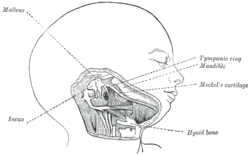
Back غضروف ميكل Arabic Cartílag de Meckel Catalan Meckelova chrupavka Czech Meckelscher Knorpel German Cartílago de Meckel Spanish غضروف مکل Persian Cartilage de Meckel French Cartilaxe de Meckel Galician Cartilagine di Meckel Italian Chrząstka Meckela Polish
| Meckel's cartilage | |
|---|---|
 Head and neck of a human fetus at eighteen weeks, with Meckel's cartilage and hyoid bar exposed. | |
 Mandible of human fetus 95 mm (3.7 in) long. Inner aspect. Nuclei of cartilage stippled. | |
| Details | |
| Precursor | First pharyngeal arch |
| Gives rise to | Incus, malleus |
| Identifiers | |
| Latin | cartilago arcus pharyngei primi |
| TE | cartilage_by_E4.0.3.3.3.1.3 E4.0.3.3.3.1.3 |
| Anatomical terminology | |
In humans, the cartilaginous bar of the mandibular arch is formed by what are known as Meckel's cartilages (right and left) also known as Meckelian cartilages; above this the incus and malleus are developed. Meckel's cartilage arises from the first pharyngeal arch.
The dorsal end of each cartilage is connected with the ear-capsule and is ossified to form the malleus; the ventral ends meet each other in the region of the symphysis menti, and are usually regarded as undergoing ossification to form that portion of the mandible which contains the incisor teeth.
The intervening part of the cartilage disappears; the portion immediately adjacent to the malleus is replaced by fibrous membrane, which constitutes the sphenomandibular ligament, while from the connective tissue covering the remainder of the cartilage the greater part of the mandible is ossified.
Johann Friedrich Meckel, the Younger discovered this cartilage in 1820.
Related :- Crypta Magna (Remnant of 2nd pharyngeal pouch from which develops the intratonsillar crypt).